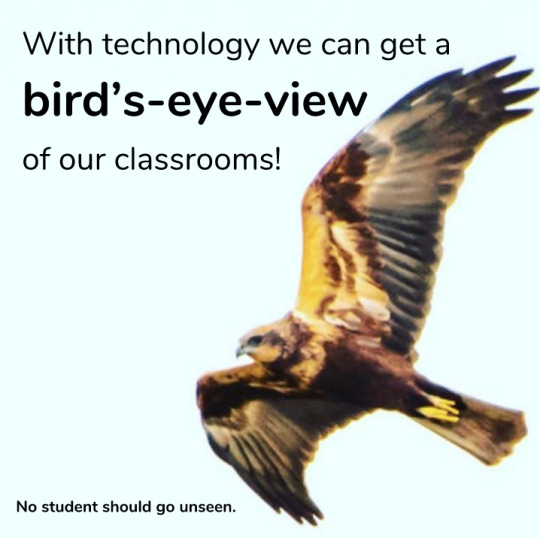An educator's thoughts on cognitive development, intelligence, and the soul.
Don't wanna be here? Send us removal request.
Text
Online Teaching
Here's a crazy idea: create some lessons online that students can complete on their own! Now, before you call that lazy, listen. I mean a full-on lesson in which all the resources they need to learn the concepts and demonstrate their learning are available. For this to be a good lesson the resources available on the online lesson would have to follow UDL guidelines so students would have a realistic opportunity to learn how they learn best. Without universal design, students could easily be left with an unhelpful resource and no teacher to even talk to about it until the next day in class. But with a hearty selection of resources, students can explore the subject on their own and at their own pace until they feel ready to move on. This is a major benefit to designing online lessons. Students will have the freedom to explore for as long as they want. Now, I must say, I’m a supporter of the human element in teaching. If computers did all the teaching, or even if human teachers taught, but always and only through computers, I think an important part of learning would be lost. We need to be taught by people and in the presence of people. But creating a number of lessons online doesn’t take from that human element. Having lessons online is allowing more direct instructions and productive learning in the classroom!
I want to challenge myself in my first couple of years of teaching to create one online lesson for every unit with enough resources within it to make that lesson more than worth doing once but a lasting resource for whatever tools, strategies, and resources I had linked to it.
More can be done with online classroom than I even know about. But I’m happy it's easy to do, and look forward to having a collection of online lesson someday soon.
0 notes
Video
youtube
Blended Learning
I think I will be a huge fan of blended learning and the flipped classroom. Though I imagine myself enjoying my time lecturing in front of the class, pontificating on each and every insightful tangent that comes my way, I don’t believe it would be time spent engaging students in very deep learning. Day in and day out of lectures put students into a haze. Learning becomes a bit of a bore. But in a flipped classroom there is the possibility for the best of two worlds. I would still be able to lecture—from my own home—and the students could spend time in class engaging in guided practice, activity, and projects instead of sleeping through my intellectual droning. I can post lectures up online for students to watch at their leisure, pausing to take notes, rewinding a minute back to hear that great joke again (yeah, because that’ll happen), or skipping ahead, passed the stuff they already know to get to the minute and a half of lecture they need without having to wade through any more. For teachers who would prefer no skipping forward, it's no difficult trick to embed questions or prompts within an online lecture that will hold students accountable.
I plan to begin incorporating flipped lessons early on in my teaching career. I think it will save time and energy in the long run and allow for better time spent in the classroom getting engaged and getting my students engaged.
0 notes
Text
UDL: Action and Expression
When creating lessons using universal design for learning we want to have the information we give our students represented in multiple ways. We’ve discussed this before. If students can choose how to learn the selected material they learn better. But this is only the half of it. As teachers using UDL, we also need to consider how our students should be able to express their understanding of what they learned back to us. More often than many of us realize, students achieve an eloquent grasp on a core concept we worked long and hard to teach them, but then we fail to recognize their achievement because we only offered them one means to demonstrate their understanding. We seem to think that if a student knows the something we want them to know that they would also know how to show us that knowledge in the limited method we ask for. But this isn’t the case. One method for demonstrating all the various forms of learning, development, and expanding vision of the world can’t promise to work for everybody or for every type of growth. This is why we must allow students alternative means of expressing what they know and offer them some degree of choice on how they demonstrate what their learning achievements have been. Learning a specific concept and knowing how to relate that new understanding to meet a teacher’s specific expectations are two different, and often, unrelated things. A student may have the concept down and still not know what actions will help a teacher recognize that. If we offer a range of ways for students to show us what they’ve learned, we will have a better chance of seeing it. And allowing students to dance, draw, whisper, write, and spill out their knowledge, however they do it best, will turn our classroom into a vivid garden of learning, a place where methods of learning become an integrated part of the environment. This benefits even the students who never struggled with expressing their learning to a teacher’s expectations. This benefits the teacher, who before, couldn’t see the growth she inspired in her young students. And of course, this benefits the student whose achievements had gone unnoticed and unacknowledged for so long. Using UDL’s guidelines for student expression of understanding benefits everybody.
Check it out!
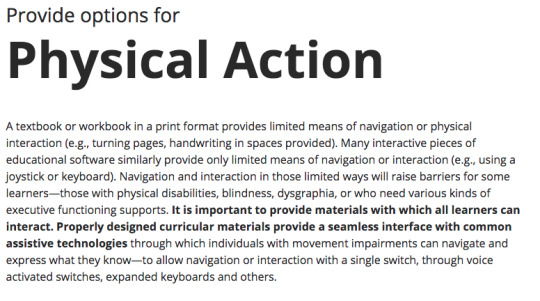
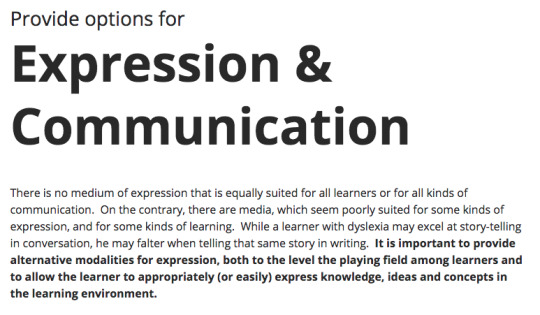
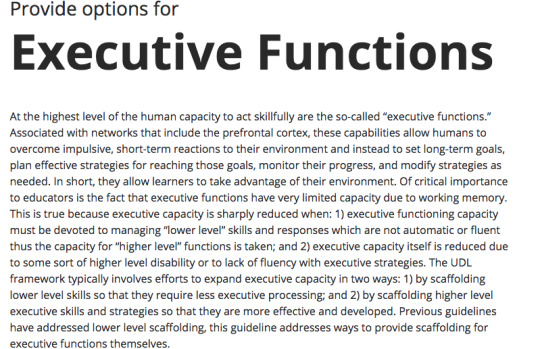
0 notes
Text
UDL: Representation
When teachers use universal design for learning when designing a lesson or unit it gets them to consider the various ways that students learn. People vary in many ways. One mind is never like another. It is to be expected that not all students will learn at the same pace through the same forms of input. How we represent knowledge or strategies is a large part of what helps or hinders student learning. If we can carefully consider what various forms of representation we are capable of sharing with our class then we can allow the students to choose how the intake information and instruction to best suit their needs or desires. It is a teacher’s job to make sure students with different learning styles can access the information in ways that make sense for them.
Using universal design for learning to design a lesson or unit allow students to not only choose the single most efficient means of intaking information but also encourages students to learn any one concept in multiple ways. This always enhances learning. Learning one thing through various styles and stimuli creates more connections in the brain with which to access that new information. Students who learn through various UDL representation options gain a wider perspective on any single concept. Students who learn most efficiently through visuals input can choose the visual information to study but also can also look into the articles available, or listen to the audio lecture. UDL offers multifaceted forms of learning that will benefit all students whether they simply engage in that one form of learning that suits them best or dip into a number of various mediums on the subject.
I plan to incorporate UDL wherever I can and I hope to increase my resources for representing information as time goes on. During my first year of teaching, I may only have a few forms of representation for certain concepts, but I plan on continually adding more ways for my students to learn as the years go by. I think universe design for learning empowers students by giving them a choice of how they to learn a concept while also giving them a sense of personal responsibility for the concepts being taught. No teacher should shrug at this concept. Get into to UDL! It benefits everyone.
Check out these guidelines for UDL Representation from http://udlguidelines.cast.org/
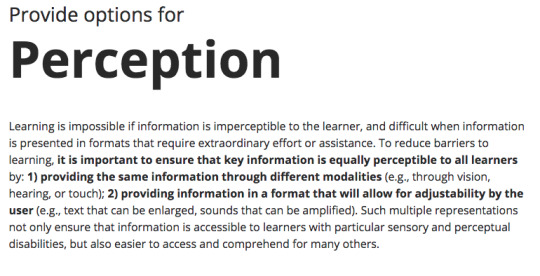
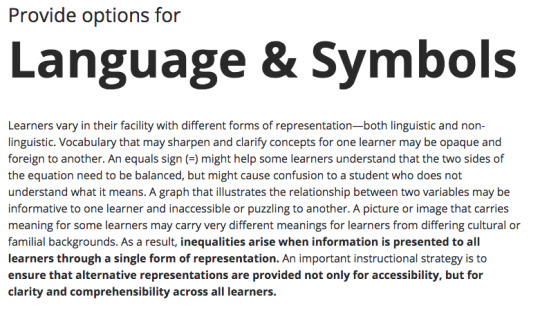
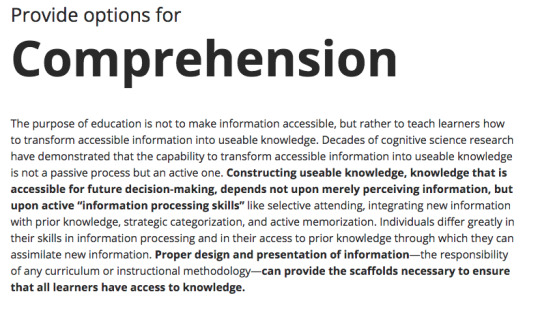
0 notes
Text
Digital Citizenship and Why We Should Teach It
Have you ever noticed how much easier it is to get frustrated with other drivers on the freeway when you are in your car rushing to get somewhere? It takes more thought to acknowledge other drivers as people just like you trying to go somewhere. When we can't see others it becomes easier to treat them thoughtlessly, without respect or consideration. This happens with online communications as well. When we post something online we don't see how it affects the people who see it. We also know that no one can see us. This anonymity often emboldens us to post extreme versions of our thoughts and intentions rather carelessly. And this can be both dangerous for ourselves and offensive towards others.
Digital Citizenship is a way using technology ethically to protect ourselves and respect others. Without a personal code of "dos" and "don'ts" it is all too easy to forget that our actions within the digital world have lasting consequences that affect real people and ourselves. A practice of Digital Citizenship helps people use technology responsibly and with a greater understanding of their tools and their power. Understanding the power of technology and how to use it increases competency and self-confidence while minimizing misunderstandings and overexposure. When we are engaged in the digital world we still must remember to be safe, kind, and responsible, just as we would be in public around real people. That's what Digital Citizenship is all about.
Why We Teach Digital Citizenship
Technology offers so much! But not everything it offers is safe, useful, or easy to comprehend. Young people are often so eager to use the newest technologies that they begin to do so without any proper guidance. Quite quickly they may find themselves off on their own in territories they don't quite understand. This leaves them vulnerable and impressionable to all types of dangers:
They may buy into untrustworthy sources or obtain disproportionate notions of what the world is like. Online social media sites often reveal a disproportionate view of friends and family who only share successes or positive attitudes that easily invalidate the reader's real struggles, especially during tough times. They may even try to compete with these disproportionate portrayals of life and begin to feel inadequate when they can't live up to them.
They may become over-exposed, sharing more information online than is safe.
Some may even become dangerous themselves without knowing it, finding it all too easy to engage in cyberbullying without ever coming face to face with any of the very real consequences.
But anyone, young or old, can find ways to use technology responsibly and effectively to do things they wouldn't have even imagined.
On the right are some guidelines and uses for technology and digital citizenship. Most of us all want to do good in the world and be treated right. How we use technology makes all the difference. Be smart. Be kind. And be responsible. Technology is an awesome and multifaceted tool for us to extend ourselves out into the world for the better!
0 notes
Text
21st Century Skills and Learning
The individual has never before had such quick access to such an abundance of information and networking possibilities. The skills and methods of learning and building personal success in the modern-day are so integrated with understanding the rapidly evolving technology that standards involving technology use are now a part of our educational curriculum.
Below is a conceptual image of the Framework for 21st Century Learning. The colored categories (red, orange, purple, and green) consist of aligned skills and themes relevant to our day and age. The grey, foundational strips at the bottom represent the support systems that offer guidelines (standards), educational tools, and constructive feedback for students learning and refining their skills for success and understanding of the modern world.
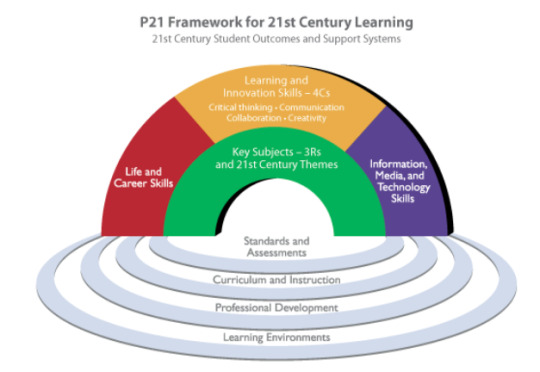
21st Century Themes (Green)
Many of the themes of our time are directly related to the international networking and global communication made so quick and easy by technology. Technology has impacted our global and individual concerns (themes) and introduced the need for various literacies.
Here are some of the major 21st Century Themes:

Many new skills, strategies, and forms of understanding have become necessary and uniquely beneficial for the individual wishing to engage effectively with these themes and issues. That’s why new standards have been established.
Below are the skills and support systems relevant to learning in the 21st century:

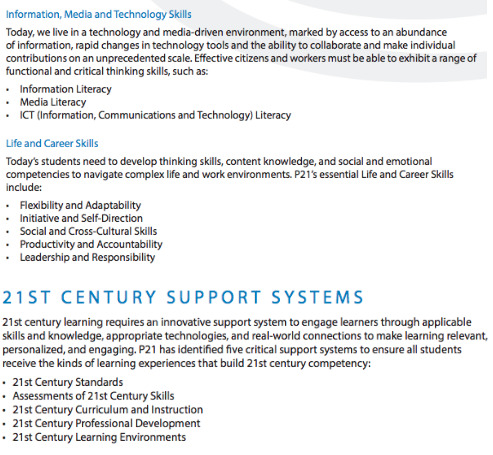
Teaching students how and when to use technology will help them apply and develop personal skills.
The International Society for Technology in Education is an organization that aids educators and students apply technology to teaching and learning. The ISTE website breaks down seven standards into applicable details and functions.
Here is a breakdown of ISTE’s first standard:
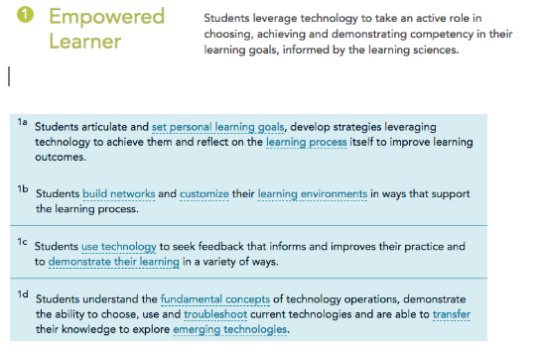
I recommend checking out the official website and learning more. https://www.iste.org/standards/for-students
0 notes
Video
youtube
I’m going to be teaching like this guy soon! I’m stoked!
0 notes
Text
Equality, Equity, & Universal Design for Learning 1
Let’s start with equality…
Is equality a purpose or a means?
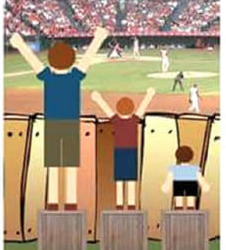
In the picture above boxes have been distributed equally among these three boys to help them watch a baseball game. Although the distribution is equal it does not help these boys equally—it only helps the boy in the middle who can’t see over the fence without at least one box. The tallest boy can watch the game on his own without a box, but he gets one anyway—in the name of equality!!! But the littlest boy still can’t see the game even when supplied with a box.
So the resources are given out equally, one box per person. Ah, equality! How grand! Well, it would’ve been just as equal to have given each boy no box at all. The practice of equality as a means doesn’t actually serve the purpose of the aid—helping as many people as possible watch the game.
Equal aid ≠ equal opportunity.
But what if equality was the purpose and not the means? Was the purpose of those boxes to ensure that everybody had one box? No! It’s not about giving everybody the same number of boxes—the game is going on! Hurry grab something to stand on so we can all see! Wasn’t that why we got the boxes out in the first place? We got out the boxes to get the heads of the boys on an equal level, not their feet. Their feet were never the problem.
0 notes
Link
Remember, books are a relatively new technology! Take advantage of them! They are a wonderful resource for information, entertainment, and insight. If you find them difficult to use this video may offer some useful tips.
1 note
·
View note
Link
Narratives have power. I find it useful to investigate the narratives we tell with a critical mind to better discover narratives that are healthy and healing and to identify narratives that may narrow perspective and obfuscate critical thinking. As an educator I plan to include a series of narrative critiques on my blog along with recommendations and warnings. Pop Detective does a really great job with his critiques of narratives and I am likely to share many of his excellent videos.
The narratives we create and subject ourselves to have significant power over our perspective that we often overlook. Most of today’s narratives give representations of overused motifs that offer little more than cultural regurgitation that feed mediocracy and lull us into black and white thinking. Such unconscious stories have little or no psychological followthrough and throw out emotional punches left and right only to grip our attention and convince us to buy into their disproportioned perspectives on life.
NARRATIVES WORTH WHILE #1
For those looking for groundbreaking narratives that disrupt the status quo with authenticity and style check out Steven Universe!
Steven Universe offers an important narrative that offers us something unique, healthy, and true. To see what I mean check out the video by Pop Detective.
0 notes
Text
Writing: A Practice of Freedom
Being literate enough to read is one thing; being able to write is another. Through reading we can learn a great many things, we can understand laws and cultural commentaries, we can hear the voices of the living and the dead. But reading alone is not a conversation. Reading is about listening to and understanding others but it is not about being listened to or being understood. To have a powerful and lasting voice in society it is more than beneficial to be able and willing to write. If reading allows us to understand and interpret laws and customs down to the detail writing allows us to create and design our laws and customs. It is the literate who hold the power. Without literacy the practice of freedom becomes stifled. As an educator I hold a critical belief that reading and writing together, true literacy, is key to the practice of freedom. I want my students to understand this and in their own ways make this connection.
One major aspect of freedom is the ability to live according to the dictates of one’s own heart. Different people view life differently and give themselves over to the service of what it is they find most important but when one is not literate enough to identify power structures they are inevitably controlled by them, adopting the values and beliefs these structures assign them. Literacy is critical to become free from these structures. It allows men and women to identify control, seek or create their own values and beliefs, and create social agreements that allow them to live by those chosen values and beliefs.
In my classroom I wish to teach literacy through a holistic approach inseparable from the creation and development of personal values, desires, and enriched living. In particular, I want to treat writing as inseparable from using one’s voice to explore, share, think, and create. I don’t plan on teaching students how to write as an isolated skill. I will teach students why to write and integrate strategies and methods of how to write as we go.
When educators teach only the how of writing they often give their students the idea that writing is simply one skill that may or may not apply to their future occupation. But when writing is taught as a part of living, part of exploring and developing the mind, of drawing connections of thought and organizing dreams and desires into plans of action, of sharing knowledge or compassion, seeking truth, creating one’s identity, and being in the world students don’t question the relevance of writing. As educators we need to show our students how writing is a part of living free and living deeply. Writing is not only about what we will do in our jobs, though being able to write will benefit anyone in nearly any occupation, but about enriching our lives by enhancing our thinking, widening our perspective, and allowing us to be heard. Writing allows us to have a say in our futures and in the design of power structures and social contracts. We are social beings and if we can read but can’t write we will be subject to structures and contracts society creates without us, structures and contracts we have no part in creating. That is not freedom. I want to teach my students that, because more than helping students find a career where they can be competent I want them to be free. To be free we have to work at it. Freedom is not given to anyone. It is learned and created. We must develop it within ourselves and practice it and share it with others. Freedom is not achieved in isolation. We must communicate.
So, what is writing?
A practice of freedom. A connection with others.
Why do we write?
To have a say in our futures, to voice our dreams, to tell those we love that we love them, to defend the underprivileged, and to teach and practice freedom.
How do we write?
First we find our reason and our audience. We tap into our internal motivations. Then we develop strategies and methods designed for our purposes, and then we practice, practice, practice. We listen and we speak, then we listen and try again.
As an educator I want to help students develop their own strategies for writing that work for them. I want to offer many examples of writing methods along with the myriad purposes for writing. I’ll show them why and how I write and I’ll ask them questions about why and how they write. I’ll listen and speak, and I’ll read and I’ll write. I will use scaffolding and offer feedback and help them learn how to reflect and evaluate their own work and the work of others. I want my student to know all through the process of writing that they are practicing something precious and sometimes difficult. They are practicing how to be free.
What do we write?
What does your heart say? Start there. That’s a good beginning.
0 notes
Text
The Costs and Contradictions of Standardized Testing
Within our schools we test children. We test them often and with a purpose. And since the report in 1983, A Nation at Risk, came forth imploring schools to take accountability for our “failing education system” standardized testing has only increased and our purpose for testing has become more narrowly defined. But testing isn’t teaching and it isn’t always helping our students or teachers. Some of the major purposes behind all this testing is to measure students’ knowledge and monitor their learning, and another is to hold schools and educators accountable through measurable statistics. And we must be held accountable. With accountability we are able to become better educators and create better schools. But to whom are we accountable? Who is holding the bar for the standards that educators and schools are trying to reach? It is the business establishment holding that bar, and this is a problem because businesses are not educators and they have an invested interest in profit and competition that has infiltrated the educational system. The purpose behind standardized testing has been assigned to schools and educators by a business oriented mindset, which limits the ways education may be used and treated by students and teachers. The purpose assigned to standardized testing and standards based education has minimized the other purposes of education, decreased the quality and quantity of course content, and undermined the importance of student and teacher roles in the classroom.
A Philosophy of Learning
Knowledge is not only a means to an end. It is much more. It is its own reward. This philosophy of education has been forgotten or blatantly ignored by the business establishment even though many educators still hold and voice this belief. An Oxford professor named John Henry Newman is known for his argument “that a true education need not, and in many cases cannot, be attached to practical purposes” (Austin, 31). A business oriented mindset can’t understand this. For those running under a profit motive knowledge is only a means to make profit. But this treatment of knowledge as only a means and not an end is detrimental to education and limits access to the inherent rewards of learning. Says Newman, “Knowledge is capable of being its own end. Such is the constitution of the human mind, that any kind of knowledge, if it'd be really such, is its own reward” (John Henry Newman; Austin, 32). There are educators that hold this philosophy but are forced to teach to a test made to appease the business entities that fund the schools. This is a contraction in the ways we view and treat knowledge. Contradiction is not in and of itself a bad thing, but here we see that one perspective has overt power over the other. If educators don’t comply to the business’ view of knowledge they may not get funded. Schools can even be shut down if testing reveals results displeasing enough.
A Nation at Risk is in many ways responsible for this imposed purpose on education. We read that “Our nation is at risk. Our once unchallenged preeminence in commerce, industry, science, and technological innovation is being overtaken by competitors throughout the world...
What was unimaginable a generation ago has begun to occur— others are matching and surpassing our educational attainments… If an unfriendly foreign power had attempted to impose on America the mediocre educational performance that exists today, we might well have viewed it as an act of war” (A Nation at Risk). We can sense the urgency and danger in these words. The rhetorical use of fear isn’t subtle but it is effective. It calls for reform, ‘we must do something!’ But it also assigns a purpose to education without consideration of any of educations other purposes. It effectively designates a single purpose to education. In an article about the far-reaching influences of A Nation at Risk entitled “Escaping the Shadow,” published in the summer of 2015, author Jal Mehta illustrates this connection: “By linking an old set of concerns about education's economic role to a new analysis of international economic competition and the shift to a post-industrial economy, A Nation at Risk succeeded in elevating the economic purpose of schooling over its other purposes” (Mehta, 23).
A Nation at Risk imposed one purpose over all others for improving our educational system: to compete; the purpose was economical, the motivation behind the purpose was to turn learners into human capital for leaders and businesses who are afraid of losing profit and the innovative edge. But this is not every individual’s reason for educating themselves and not every educator dreams of teaching children to invest themselves in international competition. Such high-stakes competition is not necessarily the best thing to impose on children to help them learn. A Nation at Risk claimed that schooling needed to improve to respond to a national economic fear, and to enforce the claim the report made any American who read the report feel that fear. “We live among determined, well educated, and strongly motivated competitors. We compete with them for international standing and markets… Knowledge, learning, information, and skilled intelligence are the new raw materials of international commerce and are today spreading throughout the world as vigorously as miracle drugs, synthetic fertilizers, and blue jeans did earlier. If only to keep and improve on the slim competitive edge we still retain in the world markets, we must dedicate ourselves to the reform of our educational system for the benefit of all—old and young alike, affluent and poor, majority and minority. Learning is the indispensable investment required for success in the “informational age” we are entering.” (A Nation at Risk) This is why we must learn. Learning is for competing in the world market. This may not be untrue. Competition may be one reason to educate one’s self, but to impose this mindset on all children attending our public school is a mistake. Learning is more than what this single viewpoint imposed on our nation.
When education is limited to such a narrow focus course content and curriculum become static. Children are beings of flesh and blood inherently invested in learning by their own nature but standardized testing enforces that they learn machine-made lessons in order to pass state tests. Rabindranath Tagore, “one of India’s most important literary figures… held in the same regard as William Shakespeare” (Austin, 40) wrote this about children in a essay he entitled To Teachers: “In childhood we learn our lessons with the aid of both body and mind, with all the senses active and eager. When we are sent to school, the doors of natural information are closed to us; our eyes see the letters, our ears hear the abstract lessons, but our mind misses the perpetual stream of ideas from nature, because the teachers, in their wisdom, think these bring distraction, and have no purpose behind them.” (Rabindranath Tagore; Austin, 42) Tagore wrote this in 1923 but it has never been more applicable than it is now with our standardized testing and teaching to the test. Student inquiry is considered more of a distraction now that test material has taken priority over all else and teachers’ shared knowledge must be curbed to match what may be on the tests. The narrow path to testing success has cut much from our education. “Many states have cut funding for music and the Arts in order to maximize time and resources for tested subjects. In short, the rise of the economic view of schooling has powerfully reshaped the divisions in educational politics and has focused the aims of schooling tightly around learning that has economic value” (Mehta, 25). This focused aim of schooling contradicts Newman’s definition of “true education” and according to Tagore interrupts the “stream of ideas from nature” that is so important to childhood development and natural learning.
Tagore offers some crucial insight that may very well help us balance our perspective of education if we could listen. “When we accept any discipline for ourselves, we try to avoid everything except that which is necessary for our purpose; it is this purposefulness, which belongs to the adult mind, that we force upon school children. We say, never keep your mind alert, attend to what is before you, what has been given you. This tortures the child because it contradicts nature's purpose, and nature, the greatest of all teachers, is thwarted at every step by the human teacher who believes in machine-made lessons rather than life lessons, so that the growth of the child's mind is not only injured, but forcibly spoiled” (Tagore; Austin, 42). Because standardized testing has such a focused goal for such limited purposes—employment, competition, and to earn schools their funding from the business establishment—it treats most natural learning and youthful exploration as a distraction. The most precious content under attack by standardized testing is the content offered by nature accessed by a child’s natural curiosity and wonder. When we rigidly teach to the test we inadvertently invalidate both nature as a teacher and the child’s natural wonder, two of education’s best tools and resources.
Tagore writes, “Children should be surrounded with the things of nature which have their own educational value. Their minds should be allowed to stumble upon and be surprised at everything that happens in today's life; the new tomorrow will stimulate their attention with new facts of life.” As educators we could dedicate some of our practice to making these “things of nature” more available to students. But as adults behaving under the pressures of a business oriented mindset we rarely consider this practice and may even see it as counteractive to our purposes. What Tagore says about adults also is true about the business establishment when he states that “the stream of lessons perpetually flowing in the heart of nature does not touch us, we merely choose those which are useful, rejecting the rest as undesirable because we want the shortest path to success” (Rabindranath Tagore; Austin, 42). We limit and discourage the best possible learning for children when we impose our reasons for learning on them. Imagine if our schooling not only allowed and encouraged student inquiry but also based a portion of the curriculum on students’ questions and concerns discovered on their own through natural living. How much better prepared would they be to face the world and respond to dilemas with information relevant to them and their life situations? Standardized testing and standards based education allows little room for this perspective or practice.
A Popular Panacea
The big idea posed by A Nation at Risk was accountability. Accountability called for measurable results of which consequences could be dependent, which in turn called for testing, which led teachers to teach to the test for better results and more savory consequences. Linda McNeil, author of Contradictions of School Reform and Director of the Center for Education at Rice University, notes how this “cure-all” of accountability has become part the public mind. “The sound bite is a simple one,” she writes, “already recognized everywhere: ‘accountability by standardized testing’ as the panacea for school reform.” She then emphasizes that “the sound bites that seduce policymakers always emphasize claims of benefits, not the actual costs” (McNeil, xxi). So what are the costs? And how do we discover them?
McNeil’s editor, Michael W. Apple, has this to say, “It is unfortunately all to usual that the most widely used measures of the ‘success’ of school reforms are the results of standardized achievement tests. This simply will not do. We need constantly to ask what reforms do to schools as a whole and to each of their participants, including teachers, students, administrators, community members, local activists, and so on. Without asking these kinds of questions we are apt to be satisfied with surface changes that offer superficially positive results while actually often making problems significantly worse in the long run.” (Michael W. Apple; McNeil, xix).
What then are these tests actually measuring to help schools and educators take accountability? The clearest measurable results offered by these tests are the educators’ and students’ compliance to the prescribed purpose. The most compliant schools, those who teach what is most economically valued, win better funding, while those schools who show little compliance or who don’t score well on those prescribed tests lose funding and sometime close.
And what about the costs of standardized testing? Are we measuring the costs? Teachers are but are often not heard. McNeil notes, “the official reports of the ‘impact’ of state policies rarely include teachers voices” (McNeil, ix). But many educators feel the costs of these standards based education policies are tremendous. In her book Contradictions of School Reform McNeil gathered the opinions of many teachers and administrators working in schools to inform her thesis that “standardization reduces the quality and quantity of what is taught and learned in schools” (McNeil, 3). What schools and educators must do to reach the standards of accountability are costly ones. She claims that the costs include not only “a decline in the quality of what is taught” but also “a new form of discrimination in the education of poor and minority kids.” But the most costly aspect of standardization “is the silencing of two voices most important in understanding the real effects of standardization: the teachers and the students” (McNeil, xxii).
An Imposed Banking Method
“In the name of improving educational quality and holding schools and school personnel more accountable for their professional practice, the state government enacted a set of standardized controls to monitor children's learning and teachers’ classroom behavior. These controls arose outside the educational system, derived from the pressures of the business establishment to fund only those educational expenses that contributed to measurable outcomes” (McNeil, 4).
If standardized testing transforms the roles of teachers and students, the two populations most relevant to education, while simultaneously silencing them as they get tested for compliance, how are we to know if any of these policies are actually improving learning? We are being asked to trust the numbers and not the people involved. This sort of reform is actually very insidious. It asks for a banking method of teaching, a method which is historically oppressive and mechanical. It rewards compliance over exploration and discourages the involvement of student inquiry and teacher knowledge. And according to teachers “the imposition of standardized controls [has] reduced the scope and quality of course content, diminished the role of teachers, and distanced students from active learning” (McNeil, 3).
The problem with the banking method of education is in its treatment of students. Just as standardized testing ignores the voices of students, so does the banking method. Paulo Freire writes in his book, Pedagogy of the Oppressed, about the insidious nature of this method. He writes, “Narration (with the teacher as narrator) leads the students to memorize mechanically the narrated content. Worse yet, it turns them into ‘containers,’ into ‘receptacles’ to be filled by the teacher. The more completely she feels the receptacles, the better a teacher she is. The more meekly the receptacles permit themselves to be filled, the better students they are” (Freire, 52–53). This is the method that businesses and states reward best. Good education is not what is being rewarded but rather methods of compliance and treatment of children as “receptacles” “to be filled.” McNeil reveals this connection of banking and the standardization reform when she points out how “the practice of teaching under these reforms shifted away from intellectual activity toward dispensing packaged fragments of information sent from an upper level of the bureaucracy.” She adds that “the role of students as contributors to classroom disclosure, as thinkers, as people who brought their personal stories and life experiences into the classroom, was silenced or severely circumscribed by the need for the class to ‘cover’ a generic curriculum at a pace established by the district and the state for all the schools” (McNeil, 5).
The real danger here is that education has become a form of daily oppression where authentic inquiry is discouraged and only time and effort spent teaching a prescribed form of knowledge is encouraged and reinforced. And because compliance and silence are ultimately supported through funding educators and students are reserving their complaints and often becoming participants in the problem. It is becoming more and more difficult to break out of the system. “Within the observational data began to emerge phony curricula, reluctantly presented by teachers in class to conform to the forms of knowledge their students would encounter on centralized tests” (McNeil, 5). It is not difficult to see how standardized testing enforces compliance and silence, tools of oppression and the installation of prescribed knowledge. Even well-meaning teachers become participatory in order to keep their positions and fit into the system that pays them for their work. According to the banking perspective of teaching, “the educated individual is the adapted person, because she or he is better ‘fit’ for the world. Translated into practice, this concept is well suited to the purposes of the oppressors, whose tranquility rests on how well people fit the world the oppressors have created, and how little they question it” (Feire, 57).
It may be frightening to acknowledge the potential oppression being practiced and taught in our schools, but we must face it if it is ever going to change. We are currently teaching oppression through this standardized testing. Even though great teachers still abound within the educational system they can only do so much good work when having to provide a good education in the midst of so much contradiction of policy and practice. We need to allow teachers and students a voice. And we need to listen and act soon because the long term effects of standardized testing is only going to widen the gap between those in power and those oppressed. “Over the long-term,” says McNeil, “standardization creates inequities, widening the gap between the quality of education for poor and minority youth and that of more privileged students. The discriminatory effects of standardization are immediately evident in the reduction in both the quality and quantity of educational content for students who have historically scored low on standardized assessments” (McNeil, 3).
Those who score low on these assessments should not be given lower quality or quantity of content. They need more education, and not the education prescribed by business leaders but a true education derived from their questions and concerns about life. Our real mission as educators “is not to ‘integrate’ [our students] into the structure of oppression, but to transform that structure so that they can become ‘beings for themselves.’” It is a difficult mission because “such transformation, of course, would undermine the oppressors’ purposes,” and those in power wish to stay in power, “hence their utilization of the banking concept of education” (Freire, 55). And so whenever possible we need to raise our voice and educate our nation on the true principles of education and the joys of learning. Tagore writes that “we insist upon forced mental feeding and our lessons become a form of torture. This is one of man's most cruel and wasteful mistakes.” (Rabindranath Tagore; Austin, 42). If we can learn from these mistakes learning may became a nationwide joy, as well as benefit to our national competence. Children deserve a good education, as good as they would get if we didn’t keep getting in their way with our prescribed purposes. Today’s children have great needs and no other human is more easily oppressed than the child. Children have very little power to change their circumstances when they are young. But they all grow up, and a teacher’s job is to help them become a being who can govern their own lives and have power over themselves, not to “teach” them to become human capital for the purposes of others who do not know them and will not listen to anything outside the chime of their own economic gains.
References:
Austin, M. (Editor) (2015). Reading the World: Ideas That Matter. Third Edition. New York, NY: W. W. Norton & Company, Inc.
Freire, P. (1996). Pedagogy of the Oppressed. London, England: Penguin Books Ltd.
McNeil, L. (2000). Contradictions of School Reform: Educational Costs of Standardized Testing. New York, NY: Routledge.
Mehtan, J. (2015, Summer). Escaping the Shadow: A Nation at Risk and Its Far-Reaching Influence. American Educator. Retrieved on October of 2017 from https://www.aft.org/sites/default/files/ae_summer2015mehta.pdf
United States. National Commission on Excellence in Education. Department of Education. (1983). A nation at risk : the imperative for educational reform : a report to the Nation
and the Secretary of Education, United States Department of Education. Washington, D.C. :The Commission : [Supt. of Docs., U.S. G.P.O. distributor].
0 notes
Text
Digital Literacy
“The fate of our species and our planet may depend of our ability to match our intellectual and technological mastery with our emotional and moral maturity.” —Roger Walsh
Digital Literacy
When I was a student in high school I didn't have a cell phone until senior year. I didn't have Snapchat, I wasn't on Facebook or Instagram or Twitter. In fact my phone couldn't send pictures or videos. I could make phone calls and I could text, and even texting was a pretty new concept. These days every student has a phone, a tiny computer with which they connect with friends, family, and a well of human knowledge. These tools, and others like them, are remarkable, useful, and dangerous. Like all tools they can be used for good or evil. They can be used to create, destroy, infiltrate, explore, share, entertain, record, and all sorts of things. As teachers we can't ignore these devices, we can’t ignore the existence of such technology in the hands of our students, and we can't deny our students access to them. They're going to use technology, and it is likely they are going to use the technology available to them with better competency than some of us will ever have. But digital literacy does not refer to competency alone. As educators we may have more knowledge about what purposes such technology may be used for. These purposes must be taught because it is likely most students will not think of them on their own.
We live in a world where digital literacy is becoming a basic skill, a fundamental form of communication and exploration within nearly every domain of life. Our students will need to be digitally literate in order to keep up with the rest of the world. In many ways our students are already extremely literate in these areas; they know how to find and operate applications on their phones and computers, how to install these applications and how to navigate the World Wide Web. But many students may still not understand all the uses and downfalls of these technologies. Often young people turn to the technologies they are most comfortable with for every question and task they are given. They overlook technologies that may be a better fit for a particular task. We often forget that a book is a form of technology. Being digitally literate means not only knowing how to use technology but knowing what technology to use for certain tasks and knowing when a task might not require a screen. Technology is a remarkable resource for a number of tasks but being able to match what technology fits best with what task is its own form of literacy not always inherent in being able to use a phone or computer with ease. This is one reason why it is important for us as educators to incorporate technology within our classroom instruction. We can model when and where technology is best effective and also when our own brains may function as a better resource than Google. When technology is overused to complete certain questions or tasks opportunities for deeper learning are often lost. It is easy for a student to Google a definition to a word and put it down on paper without internalizing the word or its meaning whatsoever. If we allow students to use technology in our classroom it will be easier for us to identify when students are overlooking ways to internalize learning with the overuse or dependence on technology and to address the issue and bring it to their attention.
My greatest concern with students use of technology is that of over-dependence and disconnect with the natural world. Having been raised playing many video games I know how wonderful and addicting technology can be. There were times I missed out on what the natural world had to offer because I was more interested in looking at a screen. In the game world I was often in control of a character or avatar that could level up and develop towards something like godhood. It felt wonderful and in many ways I felt like I could make choices that seemed to make a difference whereas in the real world I was too small for my decisions to really matter. When I turned off the game all that leveling up, that sense of godhood, was gone and I was just a little old me again. Sometimes it felt quite terrible and there were times I really didn’t want to join the real world or leave my house. So I expect to meet some students with some similar feelings. In fact I'm excited to meet them because I'm sure we'll have a lot in common. I still love games and I still believe in their potential to inspire and educate children and adults. Many games are very creative and entice players to be creative or think in new ways. I believe some games are true forms of literature or art. But there are also many many games that are just addictive fun and some that are addictive and quite violent. First person shooters have very little interesting choices to make but feel so rewarding whenever you pull that trigger and see an enemy fall to the floor that you just want to keep doing it even though there’s not much more going on there.
Tools for good and evil. Tools for creation and destruction.
My goals for learning about digital literacy and how to educate students about technology is to learn for myself what best purposes can be served by technology so that I can model these purposes for my students. I want to educate students on what purposes are worth having and, more importantly, want to learn from my students what purposes they already have and be able to introduce technologies to help them. I also want to develop my confidence in the use of technology as a means to differentiate for my students and create a classroom suitable or Universal Design for Learning. Technology is a super tool for teaching and learning. I want to focus on those purposes.
1 note
·
View note
Photo

The perspective through which you witness the universe is the crucible of your belief. With greater perspective comes greater possibility. Learn to use your eyes—all infinite number of them. What possibilities will you discover? What dreams for the future?
0 notes
